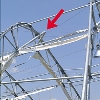
Analysts of Dallas Cowboys' Building Collapse Seek Evaluations
NIST's report on the May 2 collapse of the Dallas Cowboys' Indoor Practice Facility recommends evaluating the performance of fabric-covered steel frame structures under wind loads. Comments are invited until Nov. 6.
The National Institute of Standards and Technology will take comments until Nov. 6 on its 121-page draft report explaining why the Dallas Cowboys' Indoor Practice Facility in Irving, Texas, collapsed on May 2, 2009, during a thunderstorm. Twelve people were injured, one of them seriously, when the building's framework -- which consisted of a series of identical steel ribs supporting a tensioned fabric covering -- collapsed.
NIST estimates maximum wind gusts were 55 to 65 mph at that time, predominantly from west to east, and thus perpendicular to the long side of the building. These wind speeds are below the design wind speed of 90 mph in the national standard for wind loads. The center of a microburst associated with the thunderstorm was located about a mile southwest of the structure at the time of collapse, but researchers from NIST and the National Oceanic and Atmospheric Administration's National Severe Storms Laboratory found the wind field in the vicinity of the structure was consistent with design standards and not unusual.
The report says this was the likely collapse sequence:
- Buckling of the inner chord (inner side of the roof truss) of a frame in a section of the roof on the east side resulted in the formation of a kink in the frame.
- Failures of the east and west "knees" (connections between the side walls and the roof) allowed the frame to sway eastward with the wind.
- Compressive failure of the east side at the roof's highest point (ridge) led to fractures of the nearby inner and outer chords in the vicinity of the ridge.
- A progression of frame failures throughout the structure resulted in total structural collapse.
A diagram of the likely collapse sequence is available here.
"Our investigation found that the facility collapsed under a wind load that a building of this type would be expected to withstand," said study leader John Gross. "As a result of our findings, NIST is recommending that fabric-covered steel frame structures be evaluated to ensure the adequate performance of the structural framing system under design wind loads."
The report recommends such evaluations determine whether or not: (1) the fabric covering provides lateral bracing for structural frames considering its potential for tearing; (2) the building should be considered partially enclosed or fully enclosed based on openings, such as doors, that may be present around the building's perimeter; and (3) the failure of one or a few frame members may propagate, leading to a partial or total collapse of the structure.
Comments must be received by noon EST on Nov. 6. Submit them by e-mailing [email protected]; fax to 301-869-6275; or mail to the attention of Stephen Cauffman, NIST, 100 Bureau Drive, Stop 8611, Gaithersburg, MD 20899-8611.